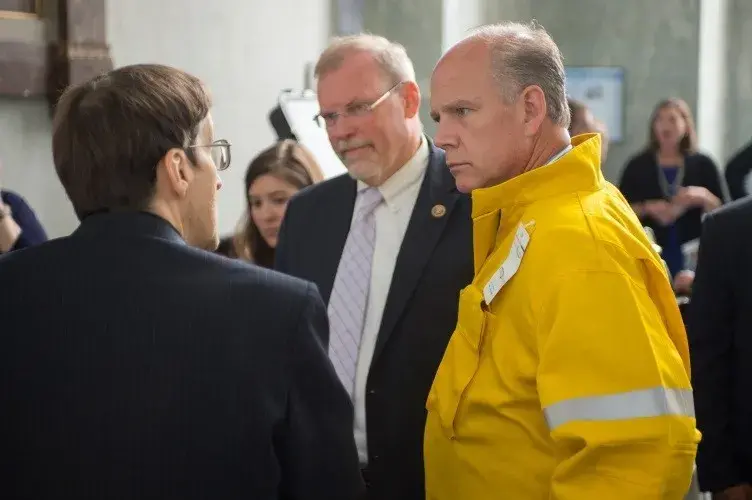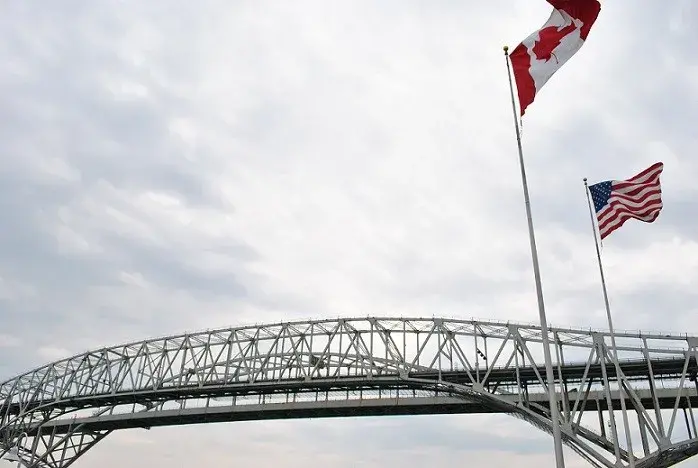The Department Homeland Security (DHS) Science and Technology Directorate (S&T) regularly posts a roundup of key updates from projects currently in the development stages in S&T's First Responders Group (FRG). This article outlines FRG's accomplishments in April, May, and June.
Hill Day Tech Demo
On June 15, S&T ventured to Capitol Hill for a First Responder Technology Hill Day where Congressional representatives had the opportunity to see how FRG is helping first  responders. Two members of Congress stopped by to see S&T’s tech first hand: Congressman Dan Donovan (R, NY-11), pictured here speaking with Program Manager Bill Deso about FRG’s new and improved wildland firefighter gear [Link no longer valid, https://www.periscope.tv/w/1RDGlwXZyDkKL] and Congressman Michael McCaul (R, TX-10), chair of the House Committee on Homeland Security, also attended and tested out several FRG and S&T technologies.
responders. Two members of Congress stopped by to see S&T’s tech first hand: Congressman Dan Donovan (R, NY-11), pictured here speaking with Program Manager Bill Deso about FRG’s new and improved wildland firefighter gear [Link no longer valid, https://www.periscope.tv/w/1RDGlwXZyDkKL] and Congressman Michael McCaul (R, TX-10), chair of the House Committee on Homeland Security, also attended and tested out several FRG and S&T technologies.
DHS S&T Under Secretary Dr. Reginald Brothers and Deputy Under Secretary Dr. Robert Griffin attended and spoke on how the event was a prime opportunity for S&T’s scientists and engineers and industry partners to illustrate how S&T is addressing the many challenges responders face on a daily basis in an effort to keep America safe.
X-Ray Scanning Rover Operational Field Assessment
On May 10, FRG and the National Urban Security Technology Laboratory (NUSTL) conducted an operational field assessment (OFA) of the X-ray Scanning Rover (XSR), technology that quickly and accurately scans packages real-time for explosive devices, while keeping responders out of harm’s way. The field tests were conducted in Arlington, Virginia, with members of the Michigan State Police, the New York City Police Department, Montgomery County (Maryland) Fire Rescue Service, and federal partner agencies. The goal: gather feedback on the XSR’s overall usability from the responders who may one day use this technology in a real emergency situation.
At the OFA, responders were briefed on operating the technology and answered questions throughout the testing. Moving forward, the company plans to make necessary enhancements to the technology based on input from the operators. NUSTL will compile results from the OFA, which will be published at www.dhs.gov/science-and-technology/first-responders.
Response and Defeat Operations Support
FRG’s Response and Defeat Operations Support (REDOPS) program helps the bomb squad community develop and evaluate technologies for rendering improvised explosive devices (IED) safe. The program achieved a major milestone during the first week in April, when Las Vegas law enforcement officers discovered an unusually configured IED. The officers turned to the FBI Las Vegas Field Office for assistance, and the field office subsequently contacted the FBI Counter-IED Unit. The unit recommended disarming the device using a method based on testing funded by the REDOPS program. The method worked, and the IED was rendered safe without any injury to people or damage to property.
Successes like this are the result of the REDOPS team continually working with the FBI Hazardous Devices School, the National Bomb Squad Commanders Advisory Board, and state and local bomb squads. Such involvement includes participation in technology evaluations and exercises like the Raven’s Challenge 2016, a series of interoperability events designed to give military ordnance technicians and public safety bomb technicians the opportunity to evaluate resources and procedures in realistic environments.
2016 Metropolitan Fire Chiefs Conference
On May 16, FRG Director Dan Cotter delivered a presentation at the 2016 Metropolitan Fire Chiefs Conference in Long Beach, California. The conference aimed to address problems and develop potential solutions to the challenges faced by fire departments in major metropolitan cities.
Cotter outlined S&T’s mission and key projects in his presentation, including: technologies from FRG’s First Responder Technologies division (like the Improved Structure Firefighting Glove and FINDER); how the Next Generation First Responder Apex program is defending against life-threatening hazards; Internet of Things (IoT) new opportunities and challenges; the latest with the International Forum to Advance First Responder Innovation; and much more.
P25 CAP Advisory Panel Meeting
On May 4-5, FRG’s Office for Interoperability and Compatibility’s (OIC) Project 25 Compliance Assessment Program (P25 CAP) Advisory Panel (AP) held its second quarterly meeting at the Department of Commerce’s Boulder Laboratories. P25 CAP is a formal, independent process for ensuring communications equipment advertised as P25 is actually compliant with P25 standards. The P25 CAP AP provides OIC with federal, state, local, tribal, and territorial perspectives on portable, handheld and vehicle-mounted radios and infrastructure equipment. Through the P25 CAP AP, OIC can support the collective interest of organizations that procure P25-compliant equipment. May 5 marked the AP’s first meeting between the public sector and industry, creating an opportunity for engagement and a wide range of P25 stakeholder input.
CAUSE IV Experiment
The fourth installment of the Canada U.S. Enhanced Resiliency Experiment (CAUSE IV) took place April 26-28 in Sarnia, Ontario, and Port Huron, Michigan. The experiment  kicked off with a test of the Public Safety Broadband Network (PSBN) with ambulances from both St. Clair and Lampton Counties. The PSBN test transitioned into a simulated tornado scenario disaster, which occurred on both sides of the border. Through live PSBN video connections, paramedics were able to provide continuous patient monitoring. The scenario illustrated that connectivity issues should not force an ambulance three miles away from a hospital to head to a hospital that is thirty miles away.
kicked off with a test of the Public Safety Broadband Network (PSBN) with ambulances from both St. Clair and Lampton Counties. The PSBN test transitioned into a simulated tornado scenario disaster, which occurred on both sides of the border. Through live PSBN video connections, paramedics were able to provide continuous patient monitoring. The scenario illustrated that connectivity issues should not force an ambulance three miles away from a hospital to head to a hospital that is thirty miles away.
The experiment displayed a great level of coordination and cooperation from both countries. On the final day, digital volunteers played a key role on either side of the border, allowing first responder agencies to analyze data from the tornado disaster area and allocate precious resources more efficiently. The experiment was also followed by an S&T #STTechTalk Twitter chat on May 24, which provided an open forum for CAUSE IV participants and the public to ask questions and share lessons learned.
eLoran Demonstration at New York Stock Exchange
On April 19, FRG and partners demonstrated eLoran, a precision timing technology for financial transactions, at the New York Stock Exchange. eLoran is a low-frequency, high-power radio navigation signal broadcast by ground-based transmission stations. This allows the signal to penetrate buildings and provide precision timing indoors and throughout urban environments
Datacasting System Debuts as an Essential Tool During Houston Floods
During the week of April 18, the City of Houston used FRG’s datacasting system to securely share information when the city experienced severe flooding. Datacasting provides public safety users with the capability to transmit secure video and data over existing broadcast television signals to a targeted audience. The Houston Fire Department used the tool to survey flooded areas during the storms affecting the city. This capability helps first responders effortlessly communicate, providing situational awareness and access to information they need to make informed decisions when responding to an incident.
New Virtual Social Media Working Group Report
In April, the Virtual Social Media Working Group (VSMWG) published its newest report, From Concept to Reality: Operationalizing Social Media for Preparedness, Response and Recovery, which contains best practices and guidance on how to operationalize social media for the public safety and emergency response communities. Government agencies commonly use social media to push information to the public; however, they often hesitate to use information from the public for operational decision-making. The report discusses the importance of operationalizing and institutionalizing social media for long-term use in decision-making and information sharing. In order for agencies to integrate social media into all aspects of preparedness, response and recovery, the report recommends considering people and processes, governance, and technology.
SAVER Reports Released
The System Assessment and Validation for Emergency Responders (SAVER) Program published more than 20 new reports from February to April, providing powerful new resources to inform purchasing decisions. The list of real-world challenges first responders face is broad and deep, ranging from budgetary and policy issues, to capability and technology limitations, to current environmental, political and social events. The most recent SAVER reports provided useful resources for law enforcement, search and rescue, emergency medical services, public safety diving, structural firefighting, security services, and the first responder community as a whole. To suggest technology for evaluation, email NUSTL@hq.dhs.gov.
For more information about the information in this article, please contact first.responder@dhs.gov.
